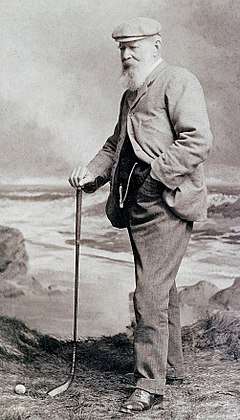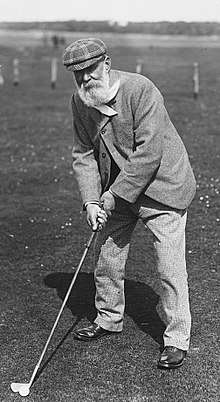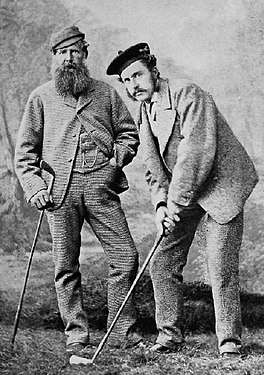Old Tom Morris
Thomas Mitchell Morris (16 June 1821 – 24 May 1908), otherwise known as Old Tom Morris, was a Scottish golfer. He was born in St Andrews, Fife, the "home of golf" and location of the St Andrews Links, and died there as well. Young Tom Morris (died 1875), also a golfer, was his son.
| Old Tom Morris | |||
|---|---|---|---|
 Morris in 1901 | |||
| Personal information | |||
| Full name | Thomas Mitchell Morris | ||
| Nickname | Old Tom | ||
| Born | 16 June 1821 St Andrews, Fife, Scotland | ||
| Died | 24 May 1908 (aged 86) St Andrews, Fife, Scotland | ||
| Nationality | |||
| Career | |||
| Status | Professional | ||
| Best results in major championships (wins: 4) | |||
| The Open Championship | Won: 1861, 1862, 1864, 1867[1] | ||
| Achievements and awards | |||
| |||
Early golf career
Morris was the son of a weaver, and was educated at Madras College in his home town. He began golf by age ten, by knocking wine-bottle corks pierced with nails (to serve as balls) around the streets of the town using a homemade club, in informal matches against other youths; this was known as 'sillybodkins'. He started caddying and playing golf from a young age, and formally was hired as an apprentice at age 14 to Allan Robertson, generally regarded as the world's first professional golfer; Robertson ran the St Andrews Links and an equipment-making business. Morris served four years as apprentice and a further five years as journeyman under Robertson, by most accounts the world's top player from about 1843 until his death in 1859.
From the early 1840s, Robertson often chose Morris as his partner in challenge matches, played by alternate shot format, which were the principal form of competition at that time. It was said the two never lost a team match played on even terms. The team became known as "The Invincibles". By the time Morris was in his early 20s he was the second-best player in St. Andrews, close to Robertson in golf skill, and won an informal match from him over the Old Course in 1843, but the two players rarely played seriously head-to-head. As Robertson's employee, Morris was in somewhat of an awkward position.[2]
Moves to Prestwick
Morris worked under Robertson at St Andrews until 1851, when he was fired on the spot after being caught by Robertson playing the new guttie golf ball; Robertson had a profitable business making the featherie ball, which was threatened by the emergence of the guttie. Morris was then hired by Prestwick Golf Club, which was just starting up. At Prestwick, he designed, laid out, and maintained the course, ran his own golf equipment business selling gutties and clubs, gave instruction to players, and ran events. He was influential in beginning The Open Championship in 1860, along with James Fairlie, and struck the very first shot in that event.
Return to St Andrews
Morris returned to St Andrews as greenskeeper and professional in 1865, at a then-generous salary of ₤50 per year. He was sought out by the Royal and Ancient, which formally passed a motion in 1864 calling for his rehiring. St Andrews was then in very poor condition, and his first task was to correct this. He did so by widening the fairways, enlarging the greens, applying greenkeeping techniques he had developed at Prestwick, building two new greens (on holes 1 and 18), and "managing" the hazards. He stayed in the post until 1903, a total of 39 years, and was kept on afterward by the R & A at full salary.[3]
Competitive highlights
Morris worked as a greenkeeper, clubmaker, ballmaker, golf instructor, and course designer, as well as playing match and tournament golf. He came second in the first Open Championship in 1860, and won the following year. He followed this up with further victories in 1862, 1864 and 1867. He still holds the record as the oldest winner of The Open Championship at 46. Also, he was part of the only father/son couple being winner and runner-up.[4]
Morris held the record for the largest margin of victory in a major championship (13 strokes in the 1862 Open Championship), which stood until Tiger Woods won the 2000 US Open by 15 strokes. He became the second player to break 80 over the Old Course, scoring 79; Robertson had been the first to do it. Once his son Young Tom Morris became an accomplished player in his own right by his mid-teens, in the mid-1860s, father and son formed a team for challenge matches, usually played by alternate shot (foursomes play), where they proved very successful. Their partnership, although not exclusive, would continue until the death of Young Tom in 1875.[3]
Golf course design, greenkeeping innovations
Morris played a role in designing courses across the British Isles. He began by assisting Robertson lay out ten holes at Carnoustie in 1842. His subsequent work included Kingussie Golf Club in 1895, Kinghorn Golf Club in 1887, Kirkcaldy Golf Club Nov 1904 9- holes then May 1906 18 holes, Prestwick, Muirfield, Machrihanish, the Jubilee Course at St Andrews, Balcomie at Crail, Moray, Bridge of Allan Golf Club, Askernish in South Uist, Lahinch and Rosapenna in Ireland, Warkworth, Wallasey and Royal North Devon Golf Club (Westward Ho!) in England, King Edward Bay Golf Club in the Isle of Man and the Castletown Golf Club in the Isle of Man.[5] Glasgow Golf Club’s Killermont course was his last 18 hole design, opening in 1904, just four years before his death.
Morris was also the father of modern greenkeeping. He introduced the concept of top-dressing greens with sand, which significantly helped turf growth. He introduced many novel ideas on turf and course management, including actively managing hazards (in the past, bunkers and the like were largely left to their own devices, becoming truly "hazardous") and yardage markers. He was the first to use a push mower to cut greens. He improved play at St Andrews by widening fairways to handle increased play, improving greens, and establishing separate teeing areas on each hole; all of these measures spread out play over larger areas, and led to better turf conditions. He created a new first green on the Old Course, and was responsible for the initial design of the New Course 1895 and Jubilee course in 1897. He also introduced the modern idea of placing hazards so that the golf ball could be routed around them; this was the beginning of strategic design, which has dominated golf course design ever since. Before his time hazards were thought of as obstacles that either had to be carried or were there to punish a wayward ball.[5] When he was 77 he was nearly beaten by Rhona Adair at St Andrews Links. Adair who was one of the leading women players. He is quoted as having said "I'll no' be licked by a lassie".[6]
Death
Morris kept working right up until his death, just before his 87th birthday. He died after falling down a flight of stairs in the clubhouse of the New Golf Club in St Andrews.
He is buried against the eastern wall of the churchyard of St Andrew's Cathedral. The grave is simple but stands beneath the highly notable monument to his son, Young Tom Morris, which carries a bronze statue of the golfer in high relief against a white background, and is visible across the breadth of the churchyard. His grave attracts thousands of golfers each year who wish to pay homage to this golfing hero.
Major championships

Wins (4)
| Year | Championship | 24 holes | Winning score | Margin | Runner-up |
|---|---|---|---|---|---|
| 1861 | The Open Championship | 2 shot deficit | 54-56-53=163 | 4 strokes | |
| 1862 | The Open Championship (2) | 11 shot lead | 52-55-56=163 | 13 strokes | |
| 1864 | The Open Championship (3) | 1 shot lead | 54-58-55=167 | 2 strokes | |
| 1867 | The Open Championship (4) | 2 shot lead | 58-54-58=170 | 2 strokes |
Results timeline
| Tournament | 1860 | 1861 | 1862 | 1863 | 1864 | 1865 | 1866 | 1867 | 1868 | 1869 |
|---|---|---|---|---|---|---|---|---|---|---|
| The Open Championship | 2 | 1 | 1 | 2 | 1 | 5 | 4 | 1 | 2 | 6 |
| Tournament | 1870 | 1871 | 1872 | 1873 | 1874 | 1875 | 1876 | 1877 | 1878 | 1879 |
|---|---|---|---|---|---|---|---|---|---|---|
| The Open Championship | 4 | NT | T4 | 7 | T18 | DNP | T4 | T8 | 11 | T14 |
| Tournament | 1880 | 1881 | 1882 | 1883 | 1884 | 1885 | 1886 | 1887 | 1888 | 1889 |
|---|---|---|---|---|---|---|---|---|---|---|
| The Open Championship | 10 | T5 | DNP | T10 | T13 | T29 | T27 | T28 | T27 | T15 |
| Tournament | 1890 | 1891 | 1892 | 1893 | 1894 | 1895 | 1896 |
|---|---|---|---|---|---|---|---|
| The Open Championship | WD | T58 | 50 | 52 | WD | 47 | WD |
NT = No tournament
DNP = Did not play
WD = Withdrew
"T" indicates a tie for a place
Green background for wins. Yellow background for top-10
Depictions in film and print
The 2016 film Tommy's Honour depicts the lives and careers of Old Tom and his son, and focuses on their complex and bittersweet relationship. It is based on Kevin Cook's Herbert Warren Wind Book Award–winning 2007 biography, Tommy's Honor: The Story of Old Tom Morris and Young Tom Morris, Golf's Founding Father and Son.
Gallery
- The golf shop of Old Tom Morris in St Andrews, Scotland, c. 1890. Morris is looking out the second storey window (upper left).
 Old Tom Morris with Young Tom Morris, c. 1870-75
Old Tom Morris with Young Tom Morris, c. 1870-75- Tom Morris, Sr., photographed in the 1890s
- An 1885 watercolor by Thomas Hodge depicting Old Tom Morris who had, on his 64th birthday, shot a score of 81 on the Old Course.
- Morris (right) with James Ogilvie Fairlie, c. 1850
 Old Tom Morris on St Andrews Links
Old Tom Morris on St Andrews Links
References
- "Tom Morris Sr". The Open. Archived from the original on 16 October 2013. Retrieved 16 October 2013.
- Tommy's Honor, by Kevin Cook, Gotham Books, New York 2007, ISBN 978-1-59240-342-4, pp. 23–33
- Tommy's Honor, by Kevin Cook, New York 2005, Gotham Books
- "Old Tom Morris". Lorrin Golf. Archived from the original on 30 June 2008. Retrieved 18 November 2007.
- "Old Tom Morris". Undiscovered Scotland. Retrieved 18 November 2007.
- Gilleece, Dermot (23 June 2001). "Old Tom had plenty to be worried about". The Irish Times. Retrieved 21 May 2018.
Further reading
- The Life of Tom Morris, by W.W. Tulloch, London 1908, T. Werner Laurie.
- The Golf Courses of Old Tom Morris, by Robert Kroeger, Cincinnati 1995, Heritage Communications.
- The Scrapbook of Old Tom Morris, by David Joy, Chelsea, Michigan 2001, Sleeping Bear Press.
- Professional Golf 1819–1885, by Peter Lewis, St. Andrews, Scotland 1998, Royal and Ancient Golf Club of St Andrews.
- Tommy's Honor, by Kevin Cook, 2007, New York, Gotham Books.
- St Andrews in the Footsteps of Old Tom Morris, by Roger McStravick, St Andrews, Scotland 2015, The Golf Book Shop.
External links
| Wikimedia Commons has media related to Old Tom Morris. |